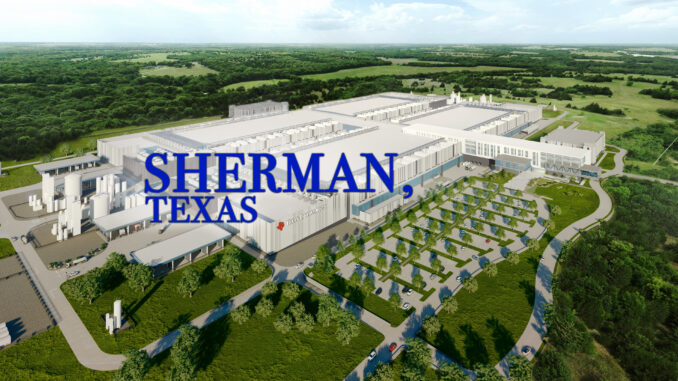
Gradually, then Suddenly, Sherman becomes the latest Lone Star State boomtown
By Nate Strauch
For most of the last 175 years, the eyes of Texas have rarely, if ever, wandered north of Dallas. In fact, most Texans would be hard-pressed to say if there is much north of Dallas, save for the money-printing casinos of southern Oklahoma.
But just an hour north of Reunion Tower, nestled between the Red River and the sprawling suburbs of McKinney, sits Sherman, Texas, county seat of Grayson County. And over the last few months, the eyes of many Texans – not to mention several national and international heavyweights of industry – have been focused firmly upon this growing city of 45,000 people.
What they’ve seen here has catapulted this historic community to the forefront of Texas’s burgeoning high-tech economy. And with Texas Instruments’ November announcement of a $29 billion (with-a-‘b’) semiconductor plant to begin construction in early 2022, suffice to say that all eyes are now wide-open to the seemingly limitless untapped potential of Grayson County, and Sherman in particular.
“People have been saying for decades that growth was coming up Highway 75, but then it never really happened,” said Sherman Mayor David Plyler, the thrice-elected executive of the city. “It had really gotten to the point where people had cried ‘wolf’ for so long, no one really believed it was going to happen anymore. But after what we’ve seen in the last few years, there aren’t many doubters left.”
It wasn’t a wolf, however, that showed up first at Sherman’s door, but a Panda. Back in 2014, Dallas-based Panda Power Funds opened a state-of-the-art, 758-megawatt, combined-cycle natural gas power plant on Sherman’s south side, providing the city with a nearby source of consistent, environmentally-friendly power generation to supply its growing base of legacy manufacturers.
Then, in 2017, Finisar (since rebranded as “II-VI”) renovated a 700,000-square-foot building in Sherman, investing $390 million of Apple’s money to create an onshore production facility for iPhone chips. And with those 500 new jobs in hand, Sherman had officially announced itself as major combatant in the Metroplex’s internecine battle to woo the next great titan of industry.
“That really put us on the map,” said Sherman City Manager Robby Hefton. “All of a sudden, the conversation switched from ‘Where’s Sherman?’ to ‘How soon can we come take a look?’ And as the jobs came, the rooftops quickly followed.”
With housing prices hovering just above $200k for a brick home, a steady stream of emigrants from cities further south and states far afield began to pay Sherman notice. A trickle of 100 new homes a year expanded to 150, then 200, and now 300 new housing starts each year – a number that’s expected to double in 2022.
But those housing numbers could soon look quaint. News broke in late November that Texas Instruments had selected Sherman over Singapore for a four-stage investment that will inject nearly $30 billion into the local economy. The new TI facility will be one of the largest factories in the United States when complete – on par with Tesla’s plant in Austin – and the 3,000 high-paying jobs that come along with it will deliver the type of growth that most cities only dream about.
“Sherman provides some unique advantages such as a competitive business environment, access to a highly trained technical workforce, and an existing supplier base,” said TI Senior Vice President of Technology and Manufacturing Kyle Flessner. “The proximity to our other manufacturing operations in Dallas and Richardson will help us further scale our efforts and build on operational efficiencies as we expand our 300-millimeter manufacturing presence in North Texas.”
TI’s decision made headlines in publications worldwide, as the company’s decision to create a long-term, domestic solution to the chip shortage was monumental in more ways than one. Texas Governor Greg Abbott was quick to join the chorus of applause, noting that the Sherman facility will do much to cement the Lone Star State as a global leader in tech.
“In addition to bringing billions of dollars in capital investment and thousands of new jobs to North Texas, this historic expansion will keep Texas a national leader in semiconductor manufacturing while also strengthening the domestic semiconductor supply chain,” Abbott said. “I thank TI for choosing Sherman as the site for its four new semiconductor manufacturing facilities as we work together to keep Texas a global hub for innovation in advanced technology and manufacturing.”
It’s heady stuff for a community that heretofore was best known as the birthplace of country legend Buck Owens. But ‘Hee Haw’ notwithstanding, preparing for this type of growth has been no laughing matter for generations of Sherman’s community leaders.
After spending decades flexing political muscle to acquire water rights in nearby Lake Texoma, Sherman moved to capitalize on those rights in 2020 through a massive expansion of its water treatment facility. That $30-million (with-an-‘m’) investment gave the city far more water than it was able to use at the time, creating a reservoir of potential, should an opportunity like the TI plant ever come along. For those keeping score at home, that investment has now paid off 1,000-fold for Sherman – an ROI that would make Choctaw Casinos blush.
“Sherman is unique compared to most of the other cities around DFW in that we control our own destiny when it comes to water,” said Hefton, the city manager. “We are able to chart our own course when we need to make hard decisions. And we’re very fortunate in Sherman that our leaders have traditionally had the foresight to make sure we would have all the water we would need. And God continues to bless our community in ways that are unimaginable.”
Now, the floodgates are open. Literally hours after the TI announcement, Hefton’s phone was already ringing. Companies large and small have reached out to learn what made Sherman so attractive, and to be next in line to take advantage of what it has to offer.
“It’s easy for your eyes to get crossed on the $30 billion, but there’s going to be a very large impact, we believe, on other businesses that may be vertically aligned with TI — suppliers or customers — that want to be close to this plant and will be looking to relocate to Sherman,” Hefton told The Dallas Morning News. “And we’re prepared for them as well.”
So, water? Check.
Jobs? Check.
Affordable housing? Write a small check.
And as for quality-of-life, well, that’s the mayor’s forte. Sherman hosts perhaps the largest free concert series in Texas, with big-names like 70s disco king KC and the Sunshine Band, 80s powerhouse .38 Special, 90s chart-toppers Fuel, and Texas-country superstar Koe Wetzel, just to name a few.
“I mean, Elvis has played in Sherman; we have a tradition to uphold,” said Plyler with a laugh, referencing a possibly-apocryphal 60s visit by The King. “People can pay their fifty bucks and see a lot of these country acts in Dallas whenever they want, but to see some of these big-name rock acts – that’s just not something that anyone else is offering. And we do it for free.”
Add to that a brand-new high school that opened last year, a re-blossoming historic downtown chockfull of locally-owned shops and restaurants, and city property taxes that are among the lowest in the state, and what you have is a recipe for sustained success that extends far beyond the big-tech headlines.
“It’s pretty remarkable, how quickly it’s all come together,” said Plyler. “You spend all these years preparing for growth, but when it arrives is out of your hands. All you can do is plant the seeds and wait for nature to do its thing.”
Those seeds needed water, and that part was already taken care of. They needed a nutrient-rich medium to take root, provided in this context by the aforementioned work in public education and conservative government. But they needed something else to sprout; some combination of luck and opportunity that would provide Sherman’s moment in the spotlight.
It was Hemingway who coined “Gradually, then suddenly,” in his 1926 book The Sun Also Rises, and it seems an apt phrase for what’s happened in Sherman in the last few years – incremental growth, followed by a day in the sun in which everything comes together.
And now that the sun has risen in Sherman, it seems the day may have only just begun.



